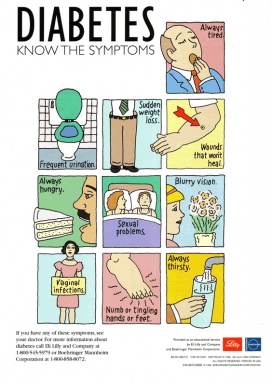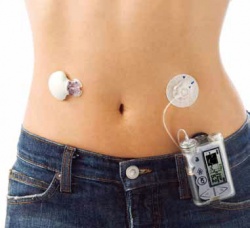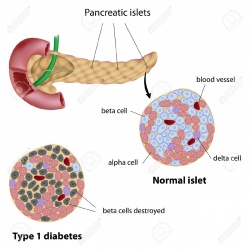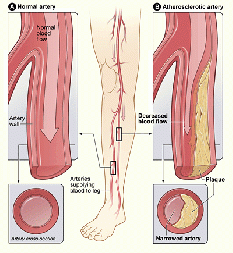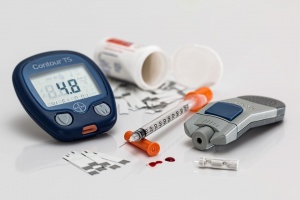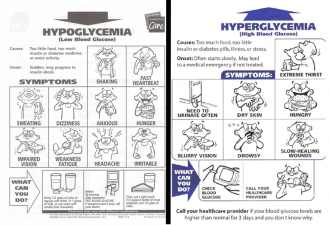Diabetes Mellitus Type 1: Difference between revisions
No edit summary |
No edit summary |
||
| Line 1: | Line 1: | ||
| | ||
<div class="noeditbox">Welcome to | <div class="noeditbox">Welcome to [[Pathophysiology of Complex Patient Problems|PT 635 Pathophysiology of Complex Patient Problems]] This is a wiki created by and for the students in the School of Physical Therapy at Bellarmine University in Louisville KY. Please do not edit unless you are involved in this project, but please come back in the near future to check out new information!!</div><div class="editorbox"> | ||
'''Original Editors '''- | '''Original Editors '''- [[Pathophysiology of Complex Patient Problems|Collen Nalley and Abbye Senn from Bellarmine University's Pathophysiology of Complex Patient Problems project.]] | ||
'''Top Contributors''' - | '''Top Contributors''' - {{Special:Contributors/{{FULLPAGENAME}}}} | ||
</div> | </div> | ||
== Definition/Description<ref name="Goodman and Snyder">Goodman CC, Snyder TEK. Differential Diagnosis for Physical Therapists: Screening for Referral. 5th ed. St. Louis, MO: Saunders/Elsevier; 2013: 425-432.</ref> == | == Definition/Description<ref name="Goodman and Snyder">Goodman CC, Snyder TEK. Differential Diagnosis for Physical Therapists: Screening for Referral. 5th ed. St. Louis, MO: Saunders/Elsevier; 2013: 425-432.</ref> == | ||
Diabetes Mellitus (DM) Type 1 is a chronic disorder characterized by hyperglycemia (high blood sugar) and disruption in metabolism of carbohydrates, fats, and proteins. It occurs because of little or no insulin being produced by the pancreas. It occurs in children or young adults, usually before the age of 30. It typically has an abrupt onset, with most individuals having a thin or normal body weight at diagnosis. Type 1 Diabetes is managed by diet, exercise, and insulin injections. It can result in serious vascular complications and neuropathies and can be a major cause of cardiovascular disease and strokes. It is also the leading cause of end-stage renal (kidney) disease, non-traumatic amputations in the lower extremity, and new cases of blindness. Autoimmune, environmental, and genetic causes may put individuals at risk of developing Type 1 DM. | Diabetes Mellitus (DM) Type 1 is a chronic disorder characterized by hyperglycemia (high blood sugar) and disruption in metabolism of carbohydrates, fats, and proteins. It occurs because of little or no insulin being produced by the pancreas. It occurs in children or young adults, usually before the age of 30. It typically has an abrupt onset, with most individuals having a thin or normal body weight at diagnosis. Type 1 Diabetes is managed by diet, exercise, and insulin injections. It can result in serious vascular complications and neuropathies and can be a major cause of cardiovascular disease and strokes. It is also the leading cause of end-stage renal (kidney) disease, non-traumatic amputations in the lower extremity, and new cases of blindness. Autoimmune, environmental, and genetic causes may put individuals at risk of developing Type 1 DM. | ||
== Prevalence<ref name="American Diabetes Association">American Diabetes Association. Type 1 Diabetes. Available from: http://www.diabetes.org/diabetes-basics/type-1/?loc=util-header_type1 (accessed 8 April 2016).</ref> == | == Prevalence<ref name="American Diabetes Association">American Diabetes Association. Type 1 Diabetes. Available from: http://www.diabetes.org/diabetes-basics/type-1/?loc=util-header_type1 (accessed 8 April 2016).</ref> == | ||
| Line 70: | Line 70: | ||
<br> | <br> | ||
<ref>Flickr. Available from: https://www.flickr.com/photos/ajc1/6266469746 (accessed 10 April 2016).</ref> | <ref>Flickr. Available from: https://www.flickr.com/photos/ajc1/6266469746 (accessed 10 April 2016).</ref> | ||
== Associated Co-morbidities <ref name="Goodman and Snyder" /> == | == Associated Co-morbidities <ref name="Goodman and Snyder" /> == | ||
| Line 96: | Line 96: | ||
*If patient is on epinephrine, glucocorticoids, or growth hormone, there may be an increase in blood glucose levels, thus an increased level of insulin may be needed. <br> | *If patient is on epinephrine, glucocorticoids, or growth hormone, there may be an increase in blood glucose levels, thus an increased level of insulin may be needed. <br> | ||
<br> [[Image:Pompa-insulinova 600 5118.jpg|center|250x250px]]<ref name="Naik Meditechs"> Naik Meditechs and Devices Pvt. Ltd. Insulin Pump. Available from: http://www.naikmeditechs.com/products/paradigm_pump.html (Accessed 8 April 2016).</ref> | <br> [[Image:Pompa-insulinova 600 5118.jpg|center|250x250px]]<ref name="Naik Meditechs"> Naik Meditechs and Devices Pvt. Ltd. Insulin Pump. Available from: http://www.naikmeditechs.com/products/paradigm_pump.html (Accessed 8 April 2016).</ref> | ||
== Diagnostic Tests/Lab Tests/Lab Values == | == Diagnostic Tests/Lab Tests/Lab Values == | ||
| Line 130: | Line 130: | ||
<br> | <br> | ||
Possible Cause:<br>The cause of the autoimmune destruction of pancreatic B-cells is still being researched, but genetics, viruses, allergens, and environmental exposures are all potential causes. It has been shown that all people with type 1 diabetes have at least one similar gene. Individuals who have a primary family member with type 1 diabetes have a 5-6% chance of developing the disease, while individuals with no family history of the disease only have a 0.4% chance of developing type 1 diabetes. <br> <br> | Possible Cause:<br>The cause of the autoimmune destruction of pancreatic B-cells is still being researched, but genetics, viruses, allergens, and environmental exposures are all potential causes. It has been shown that all people with type 1 diabetes have at least one similar gene. Individuals who have a primary family member with type 1 diabetes have a 5-6% chance of developing the disease, while individuals with no family history of the disease only have a 0.4% chance of developing type 1 diabetes. <br> <br> | ||
== Systemic Involvement<ref name="Goodman and Snyder" /> == | == Systemic Involvement<ref name="Goodman and Snyder" /> == | ||
| Line 186: | Line 186: | ||
<br> | <br> | ||
<ref>Pixabay.https://pixabay.com/en/diabetes-blood-sugar-diabetic-528678/ (accessed 9 April 2016).</ref> | <ref>Pixabay.https://pixabay.com/en/diabetes-blood-sugar-diabetic-528678/ (accessed 9 April 2016).</ref> | ||
== Physical Therapy Management (current best evidence) <ref name="Goodman and Snyder" /> == | == Physical Therapy Management (current best evidence) <ref name="Goodman and Snyder" /> == | ||
| Line 226: | Line 226: | ||
<br> | <br> | ||
[[Image:Diabetes-Hypo-and-Hyper.png|350x225px]]<ref name="wikiHow">wikihow. How to Teach Diabetes Treatment to a Child. http://www.wikihow.com/Teach-Diabetes-Treatment-to-a-Child (accessed 8 April 2016).</ref> | [[Image:Diabetes-Hypo-and-Hyper.png|350x225px]]<ref name="wikiHow">wikihow. How to Teach Diabetes Treatment to a Child. http://www.wikihow.com/Teach-Diabetes-Treatment-to-a-Child (accessed 8 April 2016).</ref> | ||
== Differential Diagnosis<ref name="Goodman and Snyder" /><br> == | == Differential Diagnosis<ref name="Goodman and Snyder" /><br> == | ||
| Line 248: | Line 248: | ||
<br> Colberg S, et al. Case Study: Alteration in run performance and aerobic power in a runner with type 1 diabetes. Diabetes Spectrum 2004; 17(2): 117-121. http://spectrum.diabetesjournals.org/content/17/2/117.full (accessed 3 April 2016). | <br> Colberg S, et al. Case Study: Alteration in run performance and aerobic power in a runner with type 1 diabetes. Diabetes Spectrum 2004; 17(2): 117-121. http://spectrum.diabetesjournals.org/content/17/2/117.full (accessed 3 April 2016). | ||
http://spectrum.diabetesjournals.org/content/17/2/117.full | http://spectrum.diabetesjournals.org/content/17/2/117.full | ||
== Resources <br> == | == Resources <br> == | ||
Revision as of 17:17, 18 April 2016
Original Editors - Collen Nalley and Abbye Senn from Bellarmine University's Pathophysiology of Complex Patient Problems project.
Top Contributors - Abbye Senn, Colleen Nalley, Lucinda hampton, Rachael Lowe, Elaine Lonnemann, Evan Thomas, WikiSysop, Fasuba Ayobami, Kim Jackson, Vidya Acharya and Amanda Ager
Definition/Description[1][edit | edit source]
Diabetes Mellitus (DM) Type 1 is a chronic disorder characterized by hyperglycemia (high blood sugar) and disruption in metabolism of carbohydrates, fats, and proteins. It occurs because of little or no insulin being produced by the pancreas. It occurs in children or young adults, usually before the age of 30. It typically has an abrupt onset, with most individuals having a thin or normal body weight at diagnosis. Type 1 Diabetes is managed by diet, exercise, and insulin injections. It can result in serious vascular complications and neuropathies and can be a major cause of cardiovascular disease and strokes. It is also the leading cause of end-stage renal (kidney) disease, non-traumatic amputations in the lower extremity, and new cases of blindness. Autoimmune, environmental, and genetic causes may put individuals at risk of developing Type 1 DM.
Prevalence[2][edit | edit source]
- ~5% of all Diabetes cases are Type 1 DM
- 29.1 million Americans had Diabetes (2012)
- 1.25 million Americans had Type 1 DM (2012)
- 208,000 Americans under the age of 20 estimated to have Diabetes, which is 0.25% of the population
Characteristics/Clinical Presentation[1][2][edit | edit source]
- Polyuria (increased urination)
- Polydipsia (increased thirst)
- Polyphagia (Increased appetite)~
- Glycosuria (glucose in urine)
- Weight loss despite polyphagia~
- Hyperglycemia (increased blood glucose)
- Ketonuria (ketones in urine)
- Fruity smelling breath
- Fatigue
- Generalized weakness
- Blurred vision
- Irritability
- Recurring skin, gum, bladder, vaginal, or other infections
- Numbness or tingling in hands or feet
- Cuts, scrapes, or bruises that are difficult or slow to heal
- Periarthritis (especially shoulder)~
- Hand stiffness
~ = Occurs primarily in Type 1 Diabetes
Associated Co-morbidities [1][edit | edit source]
- Hypoglycemia
- Hypertension
- Dislipidemia
- Cardiovascular Disease
- Blindness/Eye problems
- Kidney Disease
- Increased risk for cognitive decline/dementia (including Alzheimer’s disease)
- Sensory neuropathy, which can lead to trauma or ulceration, causing infection and ultimately may cause an amputation
- Charcot’s joint or neuropathic arthropathy (especially shoulder, hands, or feet)
- Diabetic Neuropathy
- Diabetic Ketoacidosis, resulting from high blood glucose levels that are not treated with increased insulin (usually in special circumstances of stress, trauma, surgery, pregnancy, puberty, or infectious states)
Medications[1][edit | edit source]
Insulin Injections
- Do not inject into site of active extremities within one hour of exercise because the insulin will be absorbed more quickly
- More than 20 different types sold in the US (differ by how they are made, how they work in the body, and cost)[2]
- Insulin pump
- If patient is on epinephrine, glucocorticoids, or growth hormone, there may be an increase in blood glucose levels, thus an increased level of insulin may be needed.
Diagnostic Tests/Lab Tests/Lab Values[edit | edit source]
- Fasting plasma glucose (FPG) ≥ 126 mg/dl on two different days
- A1C Levels≥ 6.5 % on two separate occasions (but must be confirmed by FPG)
- Oral glucose tolerance test ≥ 200 mg/dl
Other Information: [1]
- FPG >100mg/dl is a risk factor for future diabetes
- A1C is a measure of how diet, exercise, and/or medication/insulin have been controlling glucose over a period of time
- Normal FPG= 80-120 mg/dl
- Want to keep A1C levels below 7%
- If A1C is >10%=medical attention immediately
Etiology/Causes[1][5][edit | edit source]
Etiology:
- Type 1 Diabetes is caused by the autoimmune destruction or absence of pancreatic islet cells (B-cells). Pancreatic islet cells secrete insulin, a hormone that stimulates the body to take up glucose from the bloodstream.
- When insulin secretion is reduced, blood glucose levels are increased in the circulating blood, and a reduced amount of glucose is transported into cells.
- The impaired insulin secretion leads to impaired protein synthesis because amino acids use insulin for transportation through the body.
- Because glucose is not being taken up into cells to be utilized for energy, the body will break down adipose tissue to release glucose. The breakdown of fat causes ketone formation, which can eventually cause Diabetic Ketoacidosis (DKA) to occur. DKA can be life threatening if not treated.
- The accumulation of glucose in the blood leads to hyperglycemia.
Possible Cause:
The cause of the autoimmune destruction of pancreatic B-cells is still being researched, but genetics, viruses, allergens, and environmental exposures are all potential causes. It has been shown that all people with type 1 diabetes have at least one similar gene. Individuals who have a primary family member with type 1 diabetes have a 5-6% chance of developing the disease, while individuals with no family history of the disease only have a 0.4% chance of developing type 1 diabetes.
Systemic Involvement[1][edit | edit source]
- Systemic Involvement is due to the disease's effect on nerves and vessels.
- Infection and atherosclerosis are two long-term complications of DM, which are also usually the causes of severe illness or death of patients with DM
Atherosclerosis:
Large vessel (macro vascular) or small vessel (micro vascular)
- This occurs at an earlier age than usual in DM patients and it also progresses much faster too
- Can lead to coronary artery disease, peripheral vascular disease, cerebrovascular disease, renal artery stenosis, diabetic nephropathy (kidney disease), or diabetic retinopathy
- Example of process pictured on the left [7]
Diabetic Neuropathy: the most common chronic long-term complication of DM
- Thought to be from the accumulation of Sorbitol in nerve cells, which is a byproduct of improper glucose metabolism; this causes abnormal fluid/electrolyte shifts and nerve cell dysfunction; this along with poor vascular perfusion to nervous system tissue causes diabetic neuropathy
Other Systemic Issues:
- Impaired wound healing
- Xanthomas (fat deposits on skin) can develop on skin due to high lipids in the blood; yellow patches on the eyelids may also occur due to the same reason
- Periarthritis
Medical Management (current best evidence)[1][edit | edit source]
- Goal is to maintain blood glucose levels between 80 and 120 mg/dL. This is done through the modification of diet, exercise, and medication.
- Glucose monitoring
- Insulin injections or insulin pump
- Yearly eye and feet exams
- Daily foot inspections by patient
- A1C checked at least 2 times a year
- With retinopathy or nephropathy, avoid high intensity exercise that will significantly increase BP
- EDUCATION!
Physical Therapy Management (current best evidence) [1][edit | edit source]
- Screening examination should be done five years post diagnosis and annually thereafter; this screening includes reflexes, sensation in feet, questions about neuropathic symptoms, foot ulcers, calluses, etc.
- Exercise program
- EDUCATION
*Should not exercise alone in case of hypoglycemic episode.
*Type 1 diabetics may need to decrease insulin dose or pump activity during exercise, as well as increase food intake, with prolonged activities (10-15g CHO with every 30 min. of exercise).[9]
*Exercise increases insulin, which can drop glucose levels to low dangerous ranges, especially with high intensity or prolonged duration exercise. Monitor glucose levels before, during, and after exercise.
*Watch for confused, lethargic state or change in mental status in DM patient.
-Have patient do finger stick check for glucose levels if available and immediately refer to physician
-If patient has an insulin pump, diabetic ketoacidosis (DK) can occur quicker if there is an interruption in insulin delivery. Monitor patient carefully for excess perspiration, increased motion at pump site, and temperature during exercise.
Watch for signs and symptoms of life threatening conditions:
1. Hyperglycemia: Diabetic Ketoacidosis (DKA) can occur in type 1 DM patients . DKA usually occurs in children and young adults with undiagnosed DM, or when an individual with type 1 diabetes has increased insulin needs Be stress, trauma, surgery, infection, etc. Metabolic acidosis/HNNC (hyperglycemia hyperosmolar nonnegotiable acidosis) occurs more frequently in adults with type 2 diabetes.
-Signs/symptoms of Diabetic Ketoacidosis:[5]
-Deep, rapid breathing
-Fruity breath
-Dry skin and mouth
-Flushed face
-Nausea/vomiting
-Abdominal pain
2. Hypoglycemia: <70 mg/dl is considered hypoglycemia; This is a major complication with insulin users (type 1 DM mainly). It usually occurs from decreased food intake or an increase in physical activity. Hypoglycemia interrupts oxygen consumption in nervous tissue. Patients using beta blockers are at a higher risk for developing hypoglycemia. If hypoglycemia is suspected, 10-15 g of carbohydrate (CHO) should be given ( this equals a ½ cup of juice/cola, 8 oz. milk, 2 sugar packets, or 2 oz. honey). It is good to keep these snacks in the clinic, but always ask patient about food allergies before administering food.
Blood glucose levels in relation to exercise that a PT should be aware of:
- <100 mg/dL= give 10-15 g CHO snack and retest glucose levels 15 minutes later
- 100-250 mg/dL= safe exercise levels; proceed with treatment
- 250-300 mg/dL @ start of exercise="caution zone"; postpone exercise until stable levels are achieved; ketones in urine are checked for at these levels
- >300 mg/dL= stop exercise immediately!!!! (NOT SAFE)
Differential Diagnosis[1]
[edit | edit source]
-Type 2 diabetes
-Cancer
-Diabetes Insipidus
-Dehydration
-Hypothyroidism
Case Reports/ Case Studies[11][12] [edit | edit source]
Jacobi, T. Case Study: Type 1 diabetes in a child. General Practitioner Online 2015. www.gponline.com/case-study-type-1-diabetes-child/diabetes/type-1-diabetes/article/1371101. (accessed 3 April 2016).
http://www.gponline.com/case-study-type-1-diabetes-child/diabetes/type-1-diabetes/article/1371101
Colberg S, et al. Case Study: Alteration in run performance and aerobic power in a runner with type 1 diabetes. Diabetes Spectrum 2004; 17(2): 117-121. http://spectrum.diabetesjournals.org/content/17/2/117.full (accessed 3 April 2016).
http://spectrum.diabetesjournals.org/content/17/2/117.full
Resources
[edit | edit source]
American Diabetes Association: http://www.diabetes.org
Mayo Clinic on Type 1 Diabetes Mellitus: http://www.mayoclinic.org/diseases-conditions/type-1-diabetes/basics/definition/con-20019573
National Institute of Diabetes and Digestive and Kidney Diseases: http://www.niddk.nih.gov/health-information/health-communication-programs/ndep/living-with-diabetes/youth-teens/transition-adult-health-care/resources/Pages/resourceslist.aspx
Recent Related Research (from http://www.ncbi.nlm.nih.gov/pubmed/ Pubmed])[edit | edit source]
see tutorial on Adding PubMed Feed
Failed to load RSS feed from http://www.ncbi.nlm.nih.gov/entrez/eutils/erss.cgi?rss_guid=1T9FK3O806HVMn096LC76sSENySLvOY4E_VPWC1SJGBWPWYQ5x|charset=UTF-8|short|max=10: Error parsing XML for RSS
References[edit | edit source]
- ↑ 1.00 1.01 1.02 1.03 1.04 1.05 1.06 1.07 1.08 1.09 1.10 Goodman CC, Snyder TEK. Differential Diagnosis for Physical Therapists: Screening for Referral. 5th ed. St. Louis, MO: Saunders/Elsevier; 2013: 425-432.
- ↑ 2.0 2.1 2.2 2.3 American Diabetes Association. Type 1 Diabetes. Available from: http://www.diabetes.org/diabetes-basics/type-1/?loc=util-header_type1 (accessed 8 April 2016).
- ↑ Flickr. Available from: https://www.flickr.com/photos/ajc1/6266469746 (accessed 10 April 2016).
- ↑ Naik Meditechs and Devices Pvt. Ltd. Insulin Pump. Available from: http://www.naikmeditechs.com/products/paradigm_pump.html (Accessed 8 April 2016).
- ↑ 5.0 5.1 Medline Plus. Diabetes Type 1. https://www.nlm.nih.gov/medlineplus/diabetestype1.html (accessed 6 April 2016).
- ↑ lizenzfreie Bilder und Videos. Type 1 Diabetes. https://de.123rf.com/photo_11271329_inselzellen-der-bauchspeicheldr-se-normal-und-typ-1-diabetiker.html (accessed 8 April 2016).
- ↑ Wikipedia. Peripheral Artery Disease. https://en.wikipedia.org/wiki/Peripheral_artery_disease (accessed 9 April 2016).
- ↑ Pixabay.https://pixabay.com/en/diabetes-blood-sugar-diabetic-528678/ (accessed 9 April 2016).
- ↑ Franc S, et al. Insulin-based strategies to prevent hypoglycaemia during and after exercise in adult patients with type 1 diabetes on pump therapy: the DIABRASPORT randomized study. Diabetes, Obesity, and Metabolism 2016; 12. http://www.ncbi.nlm.nih.gov/pubmed/26264812 (accessed 7 April 2016).
- ↑ wikihow. How to Teach Diabetes Treatment to a Child. http://www.wikihow.com/Teach-Diabetes-Treatment-to-a-Child (accessed 8 April 2016).
- ↑ Colberg S, et al. Case Study: Alteration in run performance and aerobic power in a runner with type 1 diabetes. Diabetes Spectrum 2004; 17(2): 117-121. http://spectrum.diabetesjournals.org/content/17/2/117.full (accessed 3 April 2016).
- ↑ Jacobi, T. Case Study: Type 1 diabetes in a child. General Practitioner Online 2015. www.gponline.com/case-study-type-1-diabetes-child/diabetes/type-1-diabetes/article/1371101. (accessed 3 April 2016).
